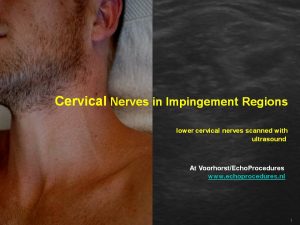Proloque: PDF: cervicaal A

We will focus on the ‘normal anatomy’ with ultrasound equipment. Regular anatomy has many variants, that is a fact. No blood vessel pattern is the same on the left / right, no nerve runs in the exact same spot. There are also more differences between inter-individuals than agreements when we observe closely. This argues for laying nerve blocks alone under ultrasound guidance, because the various nerve branches can be localized very accurately.
Although no constricted nerves are shown at this location, it is good to realize that impingement problems have many causes and are likely to be under-diagnosed because of the varied complaints presentations.
A nerve that is trapped – or has been seated – shows a fusiform thickening; sometimes the characteristic honeycomb pattern has disappeared or become blurred on your echo plate because of edema that has accumulated between the nerve fibers. The nerves can be compressed, but the accompanying arteries and veins can also be involved in clamping, with all its consequences.
Known causes of mechanical compression are: the scalene anticuss syndrome, a neck rib, form variations of the clavicle or of the first rib, bone fractures (clavicle, first rib, humerus) connective tissue strings, an enlarged processus transversus of C7 or a lung tumor (Pancoast tumor).
Besides the mechanical compression there is inflammation of the plexus brachialis by unknown cause as it is the case with neuralgic amyotrophy. The exact cause of this disorder is unknown but is thought to be a mistake of the immune system.
At Voorhorst PDF: